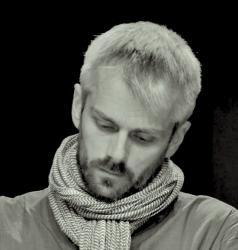In The Name Of Peace And Freedom: Jonni & The Equator Memorial Project
Jóhann Sigmarsson has been some sort of a legend since at least the early nineties when he premiered his first feature film, Veggfóður (Wallpaper) (1992). Co-written by Jóhann, or Jonni as he is known, and director Júlíus Kemp, the film focused on parties, magic mushrooms and sexual attraction. Jonni’s later cinematic endeavours include One Big Family (1995) and Plan B (2000), both of which which he wrote and directed. On its own, the mere fact that he has succeeded in making three feature-length films, while establishing and running what used to be Iceland’s only short-film festival, bears witness to a rare sense of purpose. If I’m not mistaken, his films have all focused on society’s underdogs, with a sense of humor as nasty as it is fraternal.
Recent news about Jonni’s award-winning furniture design came as a surprise, as it seems, not least to himself.

Jonni’s award-winning chair design, Andagift.
Berlin Headquarters
I met Jonni when he was on his way from the award-reception in Milan, through Berlin. An office building constructed in the GDR in 1989 has temporarily been turned into studios, until its most recent owner intends to renovate and make it fit for rental accommodation. Meanwhile, Jonni has his Berlin headquarters there, as some dozens of other artists and designers. When I arrive, at our set date in the afternoon, he is at the ground-floor café, conversing with his German coworkers, the organizers of the project-space. It is they, he tells me later, who provided him with access to concrete blocks from the Berlin Wall to ‘recycle’ into his next line of furniture. The first piece will be a meeting table, he says.
That line is yet to be produced. What Jonni has built, and what he was awarded for in Milan, was a desk and an armchair made from wood collected from a recently demolished pier in Reykjavík harbor. ‘They were going to throw it away,’ Jonni tells me. At the time, he had just finished constructing a bed, instead of buying one, and surprised himself with the result. He made some phone calls, got the wood from the harbor, kept making furniture, and the Equator Memorial Project was born.
The Berlin Wall And A Church Dome From Hiroshima
As Jonni intends to use historical monuments as raw material for furniture, he tells me that he has already sought and received approval from UNESCO. The remains of the Berlin Wall surround us in the backyard , and seem already at his disposal. Other remains are on their way, he says: material from Hiroshima, taken from a collapsed church dome close to where the A-bomb fell, material from a village in France, whose inhabitants were exterminated by the Waffen-SS, wood from piers in Hamburg and Rotterdam. Oh, and they are applying, he tells me, to use parts of the Israel-Palestine separation barrier. ‘People should respect freedom in the world,’ he explains.
Jonni also says that he tried to get remains from the site of the fallen Twin Towers in New York, but those events proved too recent, too many feelings still involved. ‘I have completely stopped thinking about getting material from the 9/11 event. It would be nice to say something about terrorism. Or war in general. If you kill a man in a war, it is sitll murder.’ He cites Yugoslavia, how friends suddenly became enemies, as the country split in three parts.

Jóhann Sigmarsson and two of his coworkers in Berlin. Background: Pieces from the Berlin wall, raw material for tables.
Auction For Peace And Freedom
Do you see the question of peace and liberty as central to the project, I ask him. ‘Yes, it is about peace and freedom,’ he replies. ‘All artists who come into the project will give part of their gains to a humanitarian charity fund. You can imagine if we make one sculpture from Hiroshima —this has not been done before. Or the separation barrier. Things have been painted on it, but no one has made furniture or sculpture out of it. No one has done it with the Berlin wall either.’ He explains how the material from the dome in Hiroshima, found somewhere down a river 30 years ago, will be used in the name of peace. The plan is, he says, to set up a fund, to which the proceedings from auctioned furniture and sculptures wil go. He, and the group already involved, are currently negotiating with auction houses.
At the end of the video interview, as shot and edited, he says that in his eyes, using historical monuments as raw material for furniture is, among other things, a new way to tell a story. Which leads me to asking, perhaps a banal question: is that where you see a continuum from your work as filmmaker, then, that you are still telling stories? Not really, it seems. ‘You know,’ he says. ‘I started as an artist. Then I became a filmmaker. I just changed my life back to art. I find the business of filmmaking a little overestimated. There’s so much bureaucracy involved. You are always waiting, waiting. If you paint, you can just be wherever you like and paint. You don’t have to crawl for anyone. That’s different. I sitll like filmmaking a lot, but there’s just so much bureaucracy in it today. Thirty years ago there was art in filmmaking, but it’s a lot more market-oriented now.’
Buy subscriptions, t-shirts and more from our shop right here!


















